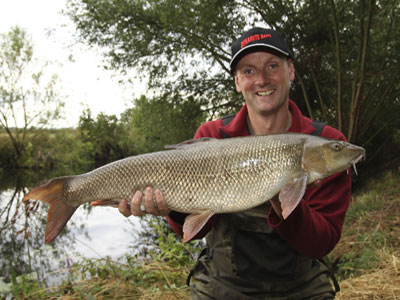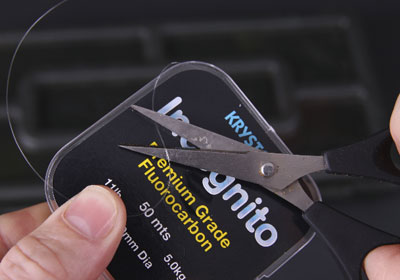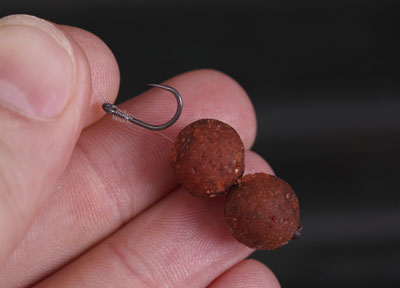Barbel might not be the brightest of fish, but when the river is low, the temperature high and anglers are numerous they can become frustratingly difficult to catch. Like all fish, they can learn to become wary of tackle and baits. Ringing the changes can pay big dividends, a lesson I have learnt many times.
On a recent visit to a busy stretch of the River Kennet it was interesting to observe the behaviour of the barbel that over the years have seen it all. In fact, this was a stretch of river that I once fished regularly, almost twenty years ago and back then the water was clear enough for us to regularly be able to observe the behaviour of the barbel at close-quarters. In those far-off days it was obvious that the barbel were very aware of tackle and baits and even when feeding hard could effortlessly distinguish baits attached to a rig than those that were not. Remember, these were fish that were caught on a regular basis and so as each season wore on they came to associate lines and hooks with a trip to the bank. Large baits, such as the, then hugely popular, rolled meat were enough to put the fear of god up the fish after the first few weeks of the season, and even small baits, such as casters would only catch the odd fish.
 Contrast the crystal clear waters of the past with water almost the colour of weak tea that appears to be the norm on the Kennet these days and which makes fish observation almost impossible. But are the fish behaving any differently? Probably not, but without actually being able to observe how the fish are behaving how can we tell that they have wised-up to our rigs and bait?
Contrast the crystal clear waters of the past with water almost the colour of weak tea that appears to be the norm on the Kennet these days and which makes fish observation almost impossible. But are the fish behaving any differently? Probably not, but without actually being able to observe how the fish are behaving how can we tell that they have wised-up to our rigs and bait?
On this day I learnt a thought-provoking lesson. We were fishing hemp and caster, probably THE best barbel baits on the planet, and a combination that I think the barbel find very hard to ignore, even when they have been caught on them numerous times. After a few early fish in a well known holding swim the savage bites stopped. Instead, the occasional positive line-bite and lots of small twitches and slow knocks on the rod top indicated that ‘something’ was still willing to have a go at the bait.
Initially, it was easy to just sit back in the belief that sooner or later the fish would gain a little extra confidence and one would make a mistake, yet after a couple of hours without any positive indications it was obvious that the fish were not going to play ball. Tying up a new rig, the 60cm braided hook length was replaced with a 120cm fluorocarbon link and the size 10 silicone tube shrouded hook with a size 14, three casters were glued to the hair (the same bait as before) and the rig lowered into position.
 For twenty minutes the tip remained motionless then, out of the blue, round it went and a barbel was hooked well back in the mouth. The next fish came after an hour or so, again the first real indication with no twitches beforehand. Finally we started getting a few more twitches before the tip went round and a third fish was hooked. Would we have caught those fish if we had stayed on the other rig? Who knows, but I am fairly convinced that the change to a more subtle rig made a difference.
For twenty minutes the tip remained motionless then, out of the blue, round it went and a barbel was hooked well back in the mouth. The next fish came after an hour or so, again the first real indication with no twitches beforehand. Finally we started getting a few more twitches before the tip went round and a third fish was hooked. Would we have caught those fish if we had stayed on the other rig? Who knows, but I am fairly convinced that the change to a more subtle rig made a difference.
The trouble is, the more subtle presentation is the one that I normally use, and have done for many years now. It is VERY rare indeed actually that I change to anything other than this when barbelling, such is my confidence in it. Yes I have caught some good fish on other set-ups, but this one out-fished others so effectively for me that I have absolute confidence in it. My thinking is simple; because it is so effective for me, why do I want to use anything else?
Interestingly, I know other barbel anglers who are more successful than me who use other rigs with bigger hooks and thicker braided lines. They have just as much confidence in what they do as I, which it has to be said is often half the battle, particularly when sitting it out for a big fish, rather than bagging up on numbers of smaller ones. Confusing isn’t it? Of course there are no hard or fast rules, but there are a few things that you can try to persuade those finicky barbel to make a mistake.
 1.Use smaller hooks
1.Use smaller hooks
I am convinced that the smaller the hook used the more barbel you will catch. The snout and lips of a barbel are incredibly sensitive and can reject unpalatable objects in a split second. I am sure this goes on a lot more than we give them credit for. Swapping to a size 14 hook (ie. Mustad Carp Power or Drennan Super Specialist) or even smaller will retain enough strength to land big barbel, but give you a significant advantage.
2.Use longer hook links
I will not fish lighter than 8lb breaking strain hook lengths for barbel, as light lines lead to protracted fights and fish that take an age to nurse back to strength. By going longer though, increasing to even 2-3 metres, can make a significant difference and bring more bites. Don’t worry about the hook link waving about in the current, it rarely happens except amongst thick weed.
3.Fish unpopular swims
This doesn’t always work, but I do think that if you are fishing areas away from the well-worn popular spots the barbel are less likely to be on edge. Given how much barbel can move around in the a river though this is difficult if not impossible to prove.
4.Use smaller baits
Small mass baits, such as hemp, casters and tiny pellets do seem to provoke a much stronger feeding response from the fish and once they get feeding they will often drop their guard. Bear in mind though that this can be a temporary thing and once they have been caught a few times on small baits they begin to lose their effectiveness.
5.Bait little and often
A very underrated tactic in my opinion (and again something that I adopt as standard practice) is to feed almost constantly with small amounts of bait, rather than dump in a load then wait. My aim is to keep particles of bait moving through the swim, creating feeding competition as the fish worry more about what their shoal mates are getting than anything else.
6.Rest the swim
By this I mean wind in and leave the swim without a rig in it for an hour or more, BUT keep feeding little and often. Barbel will often avoid tackle, and bumping in to tight lines can see them scurrying out of the swim, so it stands to reason that it is better to fish for them when they are feeding confidently than risk scaring them when the chances of a bite are slim. I often employ this tactic at the start of a session, baiting up from the off, then tackling up and fishing.
7.Pre-bait a swim
This is a topic that I have covered before, and one of the (several) benefits can be that it gives the barbel extra confidence. This isn’t always as easy as it seems though, so I would refer you to my previous article for more details of my thinking about this subject.
Whilst we all love those red letter days when the tip keeps being dragged around by another barbel they are fortunately few and far between. I would certainly soon lose interest if every time I turned up at the river the result was a foregone conclusion. Working for the fish, getting the location right and then working out the best way to get a proper bite give me far more satisfaction than just another big fish. If you can get the location right then barbel are rarely if ever uncatchable, but it certainly pays you think carefully about how you approach fishing for them.
Paul has recently launched his own website. You can find him at www.drpaulgarner.co.uk.










